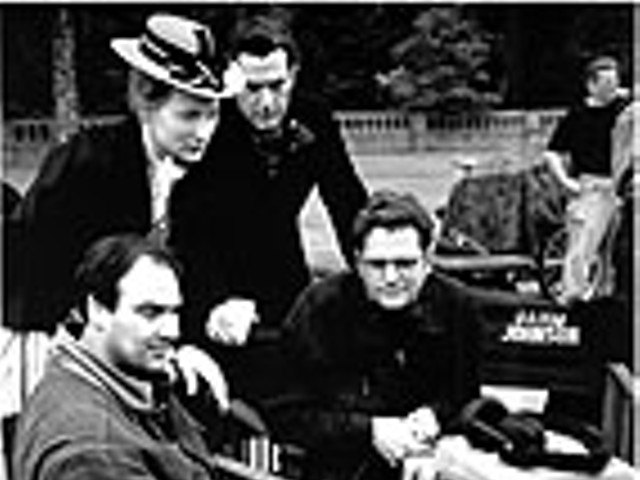John Sayles recently said, "If I’d known how hard it was to make a movie, I might not have started." Becoming a filmmaker was never a given for Sayles, who has generated controversy with the unexpected ending of his current release, Limbo. Born in 1950 and raised in an ethnically mixed, working- and middle-class factory town in upstate New York, he majored in psychology and did some theater in college, but after graduation worked as a hospital orderly, carpenter’s assistant and meat packer. Yet even as he toiled as a laborer, he was getting stories published. This led to work doing screenplays. His gift for characterization and dialogue, plus his ability to turn copy around quickly, led to numerous opportunities, including writing credits on Piranha (1978) and The Howling (1980).
Sayles’ screenwriting gigs and small roles in other directors’ films finally enabled him to finance his own projects. He established himself as the premier independent filmmaker of his generation, while inspiring the wave of independent filmmaking that began to gather steam in the mid-’80s.
The dozen feature films that Sayles has created thus far are remarkably varied in content, but certain themes and approaches prevail. Primarily character-driven and imbued with an acute sense of place, they focus on parent-child conflict, loss of innocence, redemption and the ways people struggle to negotiate daily compromises. Sayles’ stories don’t let you forget the centrality of work in most people’s lives, and he carefully highlights the dynamic interplay between the personal and the political.
His first feature, Return of the Secaucus 7 (1980), arose out of Sayles’ fascination with the idea of community and was also a response to the media backlash against the ’60s. Sort of a grittier The Big Chill, this film is about a group of former ’60s radicals, now in their 30s, who are attempting to hold onto their ideals while dealing with disillusionment and diminished expectations.
Lianna (1983) examines the price paid for independence when an immature, married young mother realizes she is a lesbian – while The Brother from Another Planet (1984) examines race by positing an alien who is a mute, psychic black guy who happens to end up in the middle of Harlem.
Baby It’s You (1982), set in a high school in Trenton, New Jersey, circa 1966, chronicles the relationship between a popular, upper-middle-class Jewish girl and her working-class Italian boyfriend. Just when it seems this may be a typical teen romance, Sayles has the girl, Jill, go off to college to confront a world where her status and identity are no longer a given, and she must struggle to recreate herself while coming to terms with the past.
Matewan (1987), about a miners’ strike in West Virginia, was based on Sayles’ research into the labor history of the ’20s and ’30s. Working during the depths of Reagan’s presidency – a time of profound historical amnesia – Sayles’ rationale was, "I think that it was important for people to remember why there were unions."
When a group of coal miners decides to strike, the company brings in black and Italian scab workers. With the help of an itinerant union organizer, the workers unionize across racial and ethnic lines, while the company responds by bringing in Baldwin-Felts agents, hired thugs employed to intimidate and even kill the embattled workers.
In Eight Men Out (1988), Sayles looks at another labor situation, only this time the exploited workers are the Chicago Black Sox who conspire to throw the 1919 World Series.
In a narrative tour de force, City of Hope (1991) juggles numerous plots and subplots to create an interconnected series of characters that comprise the social matrix of an entire city. There’s Nick, the confused son of a successful but morally compromised builder; and Wynn, a black politician trying to stay honest while dealing with the distrust of his constituency. There’s the mayor, cops, single moms, teens from a housing project, a crazy guy who runs about spouting media clichés, and even Sayles himself as a shifty, small-time criminal.
Passion Fish (1992), an intimate film set in the lush, sensual back country of southern Louisiana, chronicles the emotional journey of two women, one a white, paraplegic soap opera actress, the other her black nurse who is a recovering addict. And the Texas-based Lone Star (1995), a rich, familial and historical saga in the guise of a murder mystery, explores the way the unexamined past continues to inform and haunt the present.
Sayles’ only film set across the Atlantic, The Secret of Roan Inish (1994) is an uncanny Irish tale that celebrates storytelling through the legend of the sylkie, a beautiful creature who is both a woman and a seal.
Straying south of the border, the myth-like Men With Guns (1997), set in an unnamed Latin American country, follows the odyssey of an elderly doctor who ventures out into the countryside to reconnect with former students, only to be confronted by brutal political realities, and the depths of his own ignorance and complacency.
Unpretentious, independent, pragmatic and an exquisite craftsman, Sayles is the quintessential American artist. His oeuvre has ranged widely over the geography of this country, from urban to rural, past and present, south to north – including Alaska, the setting for Limbo – limning the faultlines of the
collective American psyche.





